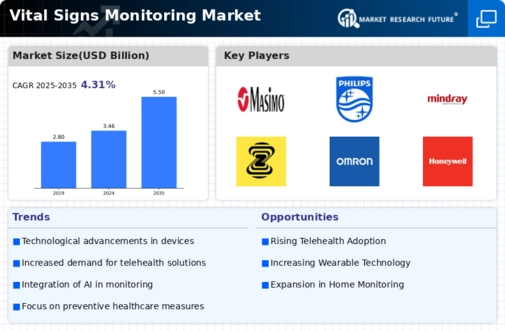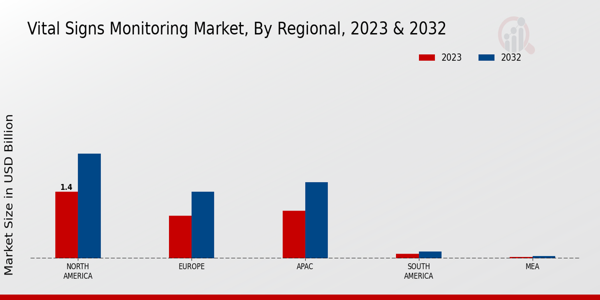Market Trends
Key Emerging Trends in the Vital Signs Monitoring Market
Some transformative trends in the vital signs monitoring market indicate the integration of advanced healthcare technologies for real-time evaluation of patients. One clear trend is an upsurge in the adoption of wearable compact and remote vital sign monitors. These include smart watches with continuous recording patches, among others, that can enable individuals to track their heart rates, blood pressure, and oxygen saturation at home or any other place outside health facilities where they can be found traditionally. Another focus area is on developing integrated systems that combine various parameters into one comprehensive platform for multi-parameter measurement, such as arterial blood pressure, heart rate, temperature, and respiratory rate. In this context, it contributes to efficient patient monitoring, thereby facilitating quick identification and response to changes in vital signs. Additionally, there have been improvements in sensor technology within the vital sign monitor market space. The use of advanced sensors enables accurate measurements with low levels of discomfort as well as ease regarding usage, thus reflecting on different non-intrusive ways used in obtaining information on clients' parameters, notably during continuous observation settings. Furthermore, there is an emergent trend that sees artificial intelligence (AI) and machine learning algorithms being incorporated into vital sign monitors. Such tools scrutinize large amounts of patient information, identifying patterns and predicting trends while providing early indications concerning possible medical problems. AI-powered monitoring of vital signs is useful in detecting small changes in physiological parameters and personalizing patient care to make it more proactive. Moreover, vital signs monitoring is expanding from traditional healthcare settings into homecare and remote patient monitoring. Such things as remote patient vital sign monitoring have contributed significantly to health workers' ability to monitor their patients' conditions, leading to early interventions while minimizing the need for physical visits. This trend is driven by a growing demand for accessible and individualized healthcare solutions, especially given the ongoing efforts to improve population health outcomes with minimized hospitalizations. Besides, there is a shift toward wirelessness and connected features within this market space. Hence, Bluetooth-disabled devices, cloud-based data storage, and mobile applications are among the factors that facilitate the seamless transmission of information between such monitors and related medical tools. As a result, an interconnected ecosystem has been formed under the influence of this trend, where systems are working together based on the essentiality of health records, thereby improving the overall effectiveness of care delivery.












Leave a Comment